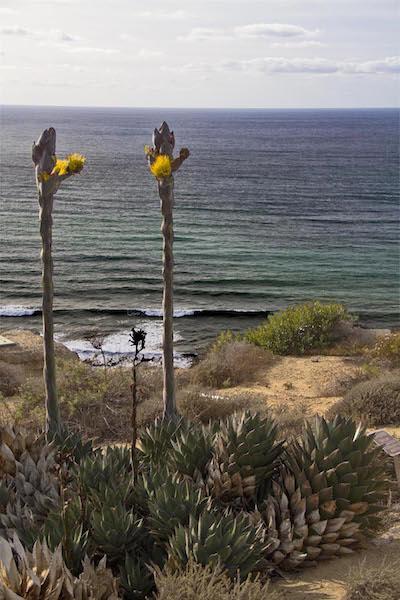
The monument to Juan Cabrillo, who landed on the point in 1542, sits on a viewpoint overlooking San Diego bay and skyline/George Oxford Miller
The view eastward from Point Loma, at just 422 feet above the Pacific, encompasses San Diego Bay, the city skyline, and the low silhouette of the Laguna Mountains against a brilliant sky. To the west, the surf pounds rocky cliffs and the steely-blue ocean stretches to the horizon. In 1542, Spanish conquistador Juan Cabrillo, the first “tourist,” gazed across the scenic landscape from this same viewpoint.
Today as many locals as tourists flock to the dramatic vista atop the rugged peninsula now preserved as the 144-acre Cabrillo National Monument. Distant airplanes angle across the sky toward the bayside airport, boats cut lazy Vs through the water, and gulls, pelicans, and other seabirds zoom overhead like expressway traffic. If any single scene captures San Diego, this is it.
But Point Loma is more than a gee-wiz view. It’s a park for all seasons, with bird and whale watching, a rugged coastline with tidal pools teaming with marine life, hiking trails, and history and military museums. The peninsula, with a lighthouse and Naval and Coast Guard stations, has been an important landmark for navigation and protection of the bay since San Diego became California’s first city in 1769.

The “sensitive” coastal sage scrub habitat covers the peninsula at Point Loma with chaparral shrubs, agaves, and other succulents/George Oxford Miller
After soaking in the expansive view, along with the selfie-taking crowds at the larger-than-life statue of Juan Cabrillo, we follow the sidewalk to the Old Point Loma Lighthouse, one of eight built in the 1850s along the western coastline.
The path winds through head-high coastal sage scrub chaparral. With only 15 percent of the once dominant vegetation remaining due to urban growth, the U.S. Fish and Wildlife Service lists it as “sensitive habitat.” The shrubby lemonade berry and black sage grow alongside buckwheats, agaves, and dudleya in the rare Mediterranean ecotype. The unusual climate with warm, wet winters and hot, dry summers exists in only five other places on the planet.
Sitting on the highpoint of the headland, the gleaming white lighthouse operated from 1855 to 1891. The oil lamp with a Fresnel lens could be seen for up to 30 miles away, but was often obscured by fog. A new communication and light station was built at the base of the bluff, was put into service in 1891, and remains an active Coast Guard facility.
The view from Whale Overlook, 100 yards south of the lighthouse, encompasses the peninsula’s western coastline. From December through March, gray whales pass just offshore on their way from Alaska to their nursery grounds in lagoons in Mexico.
The stroll back to the visitor center passes a small military museum that describes the bunkers and gun emplacements that protected the bay during WWII. The peninsula is still home of Point Loma Naval Base and the Fort Rosecrans National Cemetery with its rows of white headstones flowing across the rolling hills.
For me, the high point of the national monument is actually the lowest point. Rugged cliffs line the coast along the shoreline. The pounding surf continually crashes into the eroded bluffs, carving grottos and caves. At low tide, shallow pools in the intertidal flats harbor an array of anemones, crabs, mollusks, urchins, and other colorful marine animals and plants. The best seasons to explore the pools are fall and winter when the minus tides at full and new moons occur during daylight hours.
Walking the shoreline trail at high tide, I’m awed by the power of the relentless surf. The rolling waves explode against boulders then retreat, leaving a trail of frothy foam evaporating on the sand. Yet in the chaos, a sublime order rules as endless rows of offshore swells roll inland to surrender their might against the rocky shore. The national monument is open for day use only from 9 a.m.–5 p.m. year-round except Dec. 25 and Jan 1.
Travel writer George Oxford Miller wrote the best-selling app Guide to the Grand Canyon, Flagstaff, and Williams. He previously has written about Glacier National Park, Los Haitises National Park, Agostini National Park, Pinnacles National Park, Grand Canyon National Park, and Big Bend National Park for the Traveler.

The surf pounds the cliffs at high tide and exposes tide pools teaming with life at low tide/George Oxford Miller

 Support Essential Coverage of Essential Places
Support Essential Coverage of Essential Places







Add comment